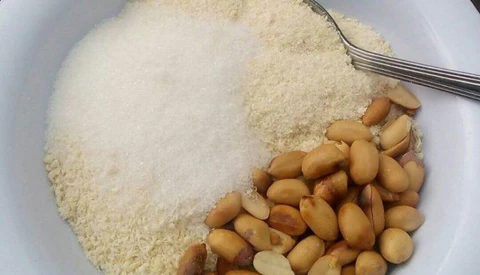By Destiny Uko
Garri, a staple food in Nigeria and many parts of West Africa, is cherished for its affordability and versatility. Consumed as eba or soaked in cold water with sugar and milk, it serves as a reliable source of energy for millions.
But a longstanding concern persists: does eating garri really damage your eyesight?
Garri is derived from cassava, a starchy root crop that undergoes multiple stages of processing–peeling, fermenting, drying, and frying—to make it safe for consumption.
This is crucial because raw cassava contains cyanogenic glycosides, which can convert into hydrogen cyanide, a harmful compound, if not properly processed.
The Link Between Cyanide and Vision
Scientific research has found that chronic cyanide exposure can lead to a condition known as tropical ataxic neuropathy (TAN), which affects the optic nerves, resulting in impaired vision or even blindness in extreme cases.
This disorder has been observed in communities where poorly processed cassava is eaten regularly in low-protein diets.
Similarly, the World Health Organisation (WHO) warns that inadequate processing of cassava may lead to cyanide intoxication, especially in regions where cassava is consumed daily without proper detoxification methods
What experts are saying
Food scientists note that garri produced using traditional methods, particularly fermentation and roasting, has minimal levels of residual cyanide and is safe for regular consumption. The risk arises only when these steps are skipped or rushed.
The belief that garri causes poor eyesight is not entirely baseless, but it is largely associated with unregulated processing rather than the food itself, according to an article published in The Conversation Africa.
Is commercially available garri safe?
The good news is that most commercially sold garri in markets and supermarkets today is properly processed. The traditional preparation methods, such as fermentation for at least 2–3 days and thorough frying, are highly effective at reducing cyanide to non-toxic levels.
Modern cassava processing methods have significantly improved the safety of cassava-derived foods like garri.
Other Causes of Vision Impairment
While it is important to be cautious about food safety, garri is not the sole cause of vision loss. Other, more common factors that contribute ato poor eyesight include:
- Prolonged exposure to screens (blue light) without protective measures or breaks
- Vitamin A deficiency, which is essential for eye health (commonly found in leafy greens, carrots, and some fruits)
- Chronic diseases such as diabetes and hypertension, which can affect vision
- Lack of regular eye check-ups and poor personal eye hygiene
Beyond just debunking myths, it is also important to recognise the nutritional value of cassava. Garri provides quick energy through its high carbohydrate content, and, when consumed with foods like groundnuts, beans, or soup, it can be a balanced meal.
Safe consumption
Here are a few simple guidelines to follow to ensure your garri consumption remains safe:
- Buy from trusted sources – reputable markets or brands that follow safety standards
- Check for signs of proper fermentation – slightly sour smell and absence of molds
- Store in a cool, dry place – to avoid spoilage and contamination
- Combine with nutrient-rich foods – such as vegetables, fish, or groundnuts
- Avoid excessive intake – Variety in diet ensures better overall nutrition
Should You Stop Taking Garri?
The widespread fear that garri causes poor eyesight stems from real concern about cyanide toxicity in improperly processed cassava, not garri itself. If processed right, garri poses no significant risk to vision.
To maintain good vision, focus on proper nutrition, regular eye care, and lifestyle adjustments. While you can still enjoy your garri, just be sure it’s from a trusted source, consumed in moderation and paired with a balanced diet.
Garri, a staple food in Nigeria and West Africa, is often associated with fears of eyesight damage due to cyanide in improperly processed cassava from which garri is derived. Properly processed cassava involves steps like fermentation and roasting, which significantly reduce cyanide levels and make garri safe for consumption. Concerns arise mainly when these processing steps are skipped, leading to potential cyanide exposure, which can cause tropical ataxic neuropathy and affect vision.
Experts assure that commercially available garri, which follows traditional methods, is safe. The warnings about eyesight are based on unregulated processing, not the food itself. Factors such as screen exposure, vitamin A deficiency, chronic diseases, and poor eye hygiene are more common causes of vision impairment.
Safe consumption of garri involves buying from trusted sources, checking for proper fermentation, and storing it correctly. Including it in a balanced diet with nutrient-rich foods further optimizes its benefits. Enjoy garri in moderation from reputable producers to minimize risks, while maintaining a nutritious diet and regular eye care for overall eye health.






